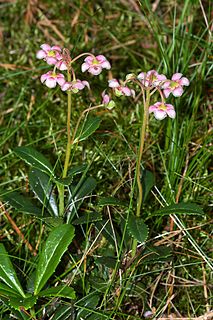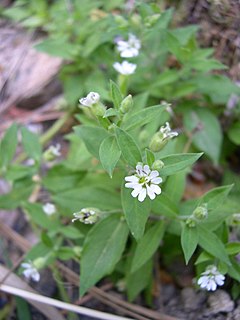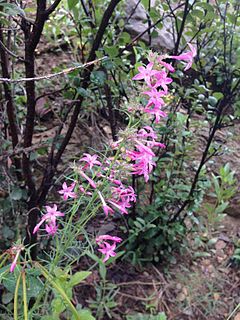
Pseudotsuga is a genus of evergreen coniferous trees in the family Pinaceae.

The Douglas fir is an evergreen conifer species in the pine family, Pinaceae. It is native to western North America and is also known as Douglas-fir, Douglas spruce, Oregon pine, and Columbian pine. There are three varieties: coast Douglas-fir, Rocky Mountain Douglas-fir and Mexican Douglas fir.

Arbutus menziesii or Pacific madrone, is a species of broadleaf evergreen tree in the family Ericaceae, native to the western coastal areas of North America, from British Columbia to California.

Amsinckia is a genus of flowering plants commonly known as fiddlenecks. The common name is derived from the flower stems, bearing many small flowers, which curl over at the top in a manner reminiscent of the head of a fiddle. Fiddlenecks are in the family Boraginaceae, along with borage and forget-me-nots. The genus is named after the patrician Amsinck family in honour of the Hamburg head of state and patron of botany Wilhelm Amsinck (1752–1831).

Scutellaria montana, with the common names largeflower skullcap, large-flowered skullcap and mountain skullcap, is an perennial forb first described by Alvan Chapman in 1878. This narrowly endemic species is found in the southeastern United States in parts of the Ridge and Valley and Cumberland Plateau Physiographic Provinces. Populations have been documented from four Tennessee counties and nine Georgia counties and is protected under the US Endangered Species act as it is a threatened species. The Latin specific epithet montana refers to mountains or coming from mountains.

The Northern California coastal forests are a temperate coniferous forests ecoregion of coastal Northern California and southwestern Oregon.

Chimaphila umbellata, the umbellate wintergreen, pipsissewa, or prince's pine, is a small perennial flowering plant found in dry woodlands, or sandy soils. It is native throughout the cool temperate Northern Hemisphere.

Chimaphila is a genus of five species of small, evergreen, flowering plants native to temperate regions of the Northern Hemisphere. They are classified in the family Ericaceae, but were formerly placed in the segregate family Pyrolaceae.

Chimaphila maculata is a small, perennial, evergreen herb native to eastern North America and Central America, from southern Quebec west to Illinois, and south to Florida and Panama.

Banksia menziesii, commonly known as firewood banksia, is a species of flowering plant in the genus Banksia. It is a gnarled tree up to 10 m (33 ft) tall, or a lower spreading 1–3 m (3.3–9.8 ft) shrub in the more northern parts of its range. The serrated leaves are dull green with new growth a paler grey green. The prominent autumn and winter inflorescences are often two-coloured red or pink and yellow, and their colour has given rise to more unusual common names such as port wine banksia and strawberry banksia. Yellow blooms are rarely seen.

Leptoceras menziesii, commonly known as rabbit orchid, is a plant in the orchid family, Orchidaceae and the only member of the genus Leptoceras. It is a slender plant, usually found in large colonies and which only flowers after fire. The flowers are small, white, pink and red on a stem up to 30 cm (10 in) tall and is endemic to southern Australia. It was one of the first orchids from Western Australia to be described and was given the name Caladenia menziesii, a name still used by some authorities.

Isocoma menziesii is a species of flowering plant in the daisy family, known by the common name Menzies' goldenbush.

Ribes thacherianum, with the common name Santa Cruz gooseberry, or Santa Cruz Island gooseberry, is a rare North American species of currant found only on one island off the coast of California.

Silene menziesii is a species of flowering plant in the family Caryophyllaceae known by the common names Menzies' campion and Menzies' catchfly. It is native to western North America from Alaska through the western half of Canada to the southwestern United States. It can be found in many types of habitat and it is quite common in much of its range. It is variable in morphology and there are a number of varied subtaxa. In general, it is a perennial herb growing from a caudex, appearing matlike, decumbent, or erect, with stems a few centimeters to over half a meter long. It is usually hairy in texture, with upper parts bearing sticky glandular hairs. The leaves are lance-shaped, oppositely arranged in pairs, and a few centimeters in length, upper leaves usually smaller than lower. Flowers may occur in a cyme at the top of the stem, or in leaf axils, or both. Each is encapsulated in a hairy, veined calyx of fused sepals. The petals are white with two lobes at the tips. The plant is dioecious with male and female plants producing different flowers. The male and female flower types look the same externally; the stamens are reduced in female plants and the stigmas are reduced in the male.
Trifolium beckwithii is a species of clover known by the common name Beckwith's clover.

Ipomopsis sancti-spiritus is a rare species of flowering plant in the phlox family known by the common name Holy Ghost ipomopsis. It is endemic to New Mexico in the United States, where it is known from only one canyon in the Sangre de Cristo Mountains. It is a federally listed endangered species.

Calochortus umpquaensis is a species of flowering plant in the lily family known by the common name Umpqua mariposa lily. It is endemic to Oregon in the United States, where it is mainly limited to the region of the Klamath Mountains on the Little River in Douglas County, in particular the Watson and Ace Williams Mountains. The flower has also been found at a single location in each of Josephine and Jackson Counties.

Linanthus pungens is a species of flowering plant in the phlox family known by the common names granite prickly-phlox and granite gilia. It is native to western North America from British Columbia to Baja California and east to Montana and New Mexico.
















